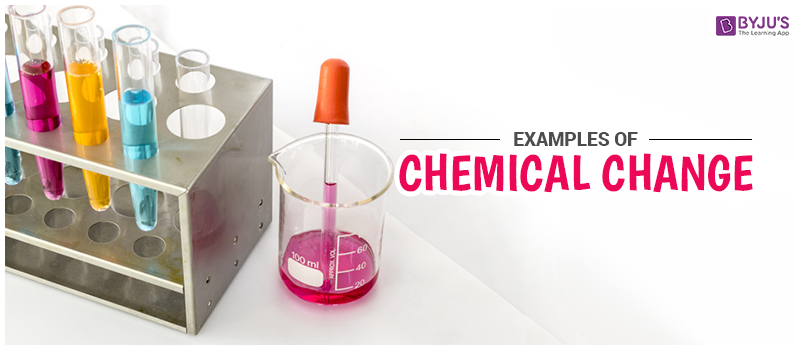Which Processes Represent A Chemical Change And One Physical Change
What is a Chemical Change?
A chemical change is a change of materials into another, new materials with different properties and one or more ane new substances are formed.
It results when a substance combines with another to grade a new substance (synthesis or either decomposes to form more than substances). The oxidation reaction is a chemical alter case that causes a chemical reaction.
They are generally irreversible except by further chemical reactions. Chemic change examples include chemical reaction which develops the dye in the colour and creates a chemic change in the pilus. There are three types of chemical changes namely organic, inorganic and biochemical alter.

Chemical Change Examples
Examples of Chemical Change in Everyday Life
Chemical changes happen effectually us all the fourth dimension and not just in a chemistry lab. Some chemic modify examples in our everyday life are mentioned below.
- Burning of newspaper and log of wood
- Digestion of food
- Boiling an egg
- Chemical bombardment usage
- Electroplating a metal
- Blistering a cake
- Milk going sour
- Various metabolic reactions that take place in the cells
- Rotting of fruits
- Decomposition of waste
- The explosion of fireworks
- The reaction between salts and acids.
- Rusting of iron
- Lighting a matchstick
Recommended Videos

Chemical Changes Involving Organic Compounds
Organic Compounds are complex compounds of carbon in which 1 or more atoms are covalently linked to atoms of other elements. Some examples of chemical modify involving organic compounds are stated below.
1. Burning of a Natural Gas
This is a clear example of a combustion reaction. Natural gas comprehends methyl hydride gas. When methane reacts with oxygen in the atmosphere it produces water and carbon dioxide. Hence, it is an example of chemical change.
ii. Ripening of Fruits
It involves a series of changes. Fruits consist of ethylene. At that place is an increase in ethylene production when fruit gets damaged or when information technology is plucked. This results in the production of new enzymes which in turn reacts with the chemical present on the fruit. Then, the fruit may witness several changes. Some changes are mentioned below.
- The fruit becomes more juicy and soft.
- Due to the breakdown of chlorophyll, the outer peel of fruit changes its color.
- Aroma emits from ripe fruit.
Chemic Changes Involving Inorganic Compounds
The reactions of compounds and elements that exercise non involve carbon atoms are the chemical changes involving inorganic compounds. Some examples of chemical alter that involves inorganic compounds are mentioned below.
i. Formation of Steel
It is an irreversible process. Steel is formed by the addition of several other elements in definite quantities to atomic number 26, the bones element being carbon. This results in the formation of new substances, thus considering it has a chemical change. Properties of the newly formed substances are different from that of iron.
2. The lighting of a Firework
Firework consists of metal nitrates thus constituting to burning compounds. When firework is lit, combustion takes place leading to the formation of a new substance with the emission of lite and heat. Thus, it can be considered as a chemic change.
Biochemical Changes
Information technology deals with the chemistry of the activity and the growth of living organisms. An example of biochemical changes is mentioned beneath.
Photosynthesis
Photosynthesis is a process that is mainly used by plants to convert low-cal energy into chemic energy. It is a chemical process that occurs in plants. In this process, plants convert h2o and carbon dioxide into sugars and oxygen.
Solved Example
1. Milk turns sour due to
(a) Conversion of lactose in lactic acid
(b) Increased chemical changes
(c) Conversion of lactic acid into lactose
(d) Both A and B
Ans: (d)
FAQs
1. Which is an example of a chemical alter?
Ans: A chemic transition is the result of a chemical reaction, whereas a concrete modify is when the structure of affair changes, but not the chemical identity. Called-for, cooking, rusting and rotting are examples of chemical changes.
2. What is called chemical alter?
Ans: A chemic transition, also known equally a chemic reaction, is a process that transforms one or more than substances into one or more than new and different substances. A chemical transformation, in other words, is a chemical reaction involving the rearrangement of atoms.
3. What is the evidence of a chemic change?
Ans: Chemical transition atmospheric condition: colour change, precipitate germination, gas formation, smell change, change in temperature.
4. Is wood called-for a chemical change?
Ans: Wood burning is a chemical change when new materials are created that cannot be removed (e.g. carbon dioxide). For example, if a fireplace burns forest, in that location is no longer wood but ash. Certain examples include a candle called-for, atomic number 26 rusting, cake baking, etc.
5. Is milk souring a chemical change?
Ans: Chemical change requires a molecular level change to cease it from beingness reversed because it creates a new substance. Souring milk is a opposite procedure and new molecules are produced. Another example of chemical alter — creating new air, bubbles, and colour changes like rust formation.
Stay tuned with BYJU'S to acquire more interesting topics in Chemistry. Too, become various engaging and interactive video lessons to learn more effectively.
Which Processes Represent A Chemical Change And One Physical Change,
Source: https://byjus.com/chemistry/example-chemical-change/
Posted by: cliffordbutertench.blogspot.com


0 Response to "Which Processes Represent A Chemical Change And One Physical Change"
Post a Comment